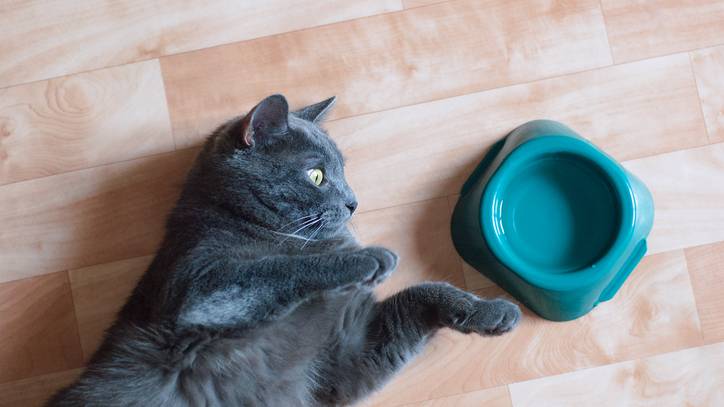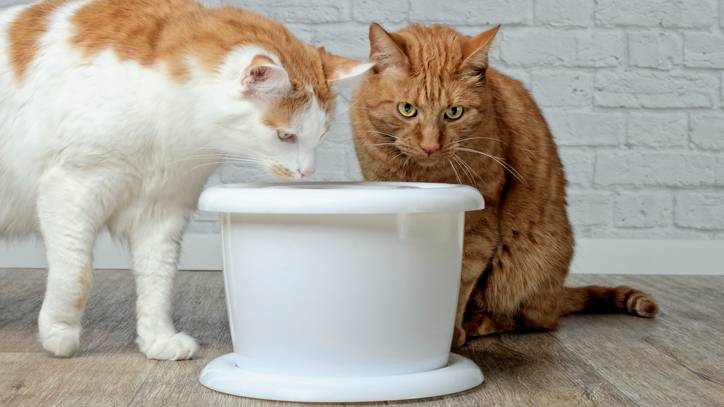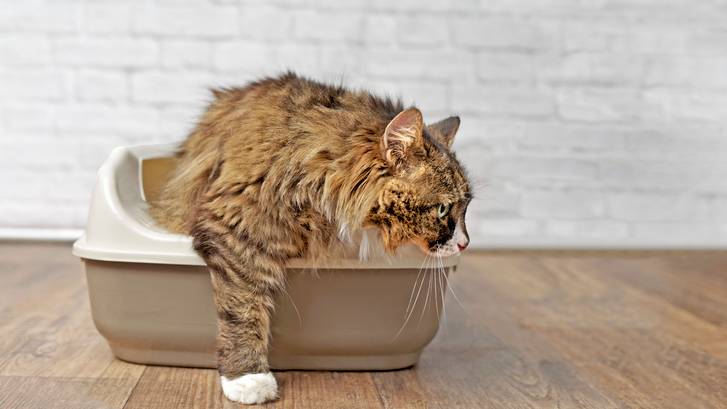
Insufficient fluids can cause serious problems in any mammal, and dehydration in cats is no exception. Just like in humans, the bodies of cats are around 60% water so their fluid intake needs to be kept at healthy levels. Water is essential for all normal bodily functions including digestion and circulation.
Many factors influence how much your cat should normally be drinking, including their age, activity level, general health, whether or not they’re fed on dry cat food and even the weather. Not drinking enough, though, can quickly lead to dehydration. One of the issues owners can face is that, unlike dogs, many cats simply don’t like drinking water. As desert animals they’ve evolved to have a low thirst drive and tend to survive on less water than dogs. Cats tend to prefer running water to still, so may happily drink from a fountain but won’t touch a bowl.
Our vet explains the symptoms and causes of dehydration, what you can do to help prevent and manage it and when to seek veterinary advice.
Causes of dehydration in cats
Normal, healthy adult cats are unlikely to get seriously dehydrated. Like all animals, their body carefully regulates the amount of water they lose through urine and faeces and prompts them to drink when they need more.
However, there are certain events that make dehydration in cats more likely to occur:
Type of cat food
Cats are descended from desert-dwellers, meaning they have a low thirst drive. Instead, wild cats get most of their water from their food. Domestic cats, on the other hand, aren’t usually eating much in the way of prey.
This means the type of cat food can make a big difference to how much fluid a cat takes in. While wet cat foods are close to prey in moisture content, dry cat foods are low-moisture, meaning cats need to increase their water intake.
Dry foods don’t cause dehydration in cats, but they can make cats more susceptible if they have another issue like kidney disease.
Lack of access
Cats get dehydrated when they don’t have access to water. A classic example is a cat who is trapped in a shed, outbuilding, attic, or locked car. These cats will rapidly become dehydrated as they’re unable to drink or even get water from their food. This is especially the case in warm weather.
Cats are also fussy about where they drink, preferring open spaces, running water, and peace and quiet. This means it’s quite common for pet parents to think their cat is not drinking, but healthy adult cats will almost always be taking in enough water to avoid dehydration.
Having said this, it’s possible that a cat will become dehydrated if his preferred drinking place is inaccessible – for instance if the bird bath freezes over, or a neighbor cat moves in and guards the pond.
Medical conditions
Dehydration in cats also happens when cats are ill. Medical conditions like kidney disease and diabetes cause cats to urinate more than usual, drawing water out of the body. If cats don’t respond by taking in enough water, they’ll soon become dehydrated.
Cats are unlikely to become severely dehydrated like this, but they’re often mildly dehydrated for long periods of time, which is just as damaging. Of course, if a medical condition causing increased fluid loss is combined with a lack of water to drink – perhaps you forgot to fill the water bowl – then dehydration will happen much more quickly.
Vomiting and diarrhea can also cause dehydration, especially in kittens or older cats. Cats will usually drink more to make up for their increased losses, but if they can’t keep up, they’ll become dehydrated quickly.
Very young kittens (less than four months old) can become severely dehydrated in a matter of hours if they have vomiting or diarrhea.

Signs of dehydration in cats
Knowing how to check if your cat is dehydrated is key to acting quickly to get them the help they need.
Dehydrated cats may be lethargic, and quieter than usual. You might find that they’re thirsty and drinking more than usual, but not always – especially if nausea is preventing them from wanting to drink.
You might notice that their eyes are more sunken, or that their coat is dull. In severe dehydration you’ll notice them urinating less and their pee becoming strong-smelling, but don’t rely on this as a sign, as some of the causes of dehydration make cats urinate more than usual.
Other signs include:
How do you check a cat for dehydration?
If you suspect your cat is dehydrated, there are some simple checks you can do at home. The first is to pull the skin on the back of their neck up into a ‘tent’.
When you let go, the skin should return to its previous position quickly. If your cat is dehydrated, their skin will stay in a tent, or slowly return to its previous position. A loss of skin elasticity like this is a sign of severe dehydration that requires veterinary treatment.
Another quick test you can do, if your cat is amenable, is to touch your cat’s gums with a finger. (Please don’t do this if your cat might bite!) If the gums feel sticky or dry, your cat is dehydrated. Normal gums should be constantly moistened by saliva.
Will a dehydrated cat urinate?
Dehydrated cats will continue to urinate, as the body has to get rid of waste products. However, the urine will become steadily more concentrated as dehydration worsens, turning it darker in color, stronger-smelling, and smaller in amount.
You may see your cat urinating less, but some causes of dehydration (like kidney failure) cause cats to pee more, so you shouldn’t rely on urination as a sign of dehydration in cats.

How long does it take for a cat to become dehydrated?
Like humans and other mammals, cats need to take in water on a regular basis to prevent dehydration. Cats naturally get much of this water from their food – rodents and other prey animals are about 80% water, which means that, given the right diet, they need to drink very little water to survive.
How long it takes for a cat to become dehydrated depends not only on their diet, but also on their activity levels, the ambient temperature, and their internal processes (such as illness or pregnancy).
Broadly speaking, a cat without access to water or food can die of dehydration in as little as a couple of days. Cats that are eating well and drinking well but that have an underlying illness meaning they’re passing more water as urine than they are drinking will slowly become dehydrated over a week or more.
How to prevent dehydration in cats
Preventing dehydration in cats is all down to increasing fluid intake. In some cats, you may also be able to reduce fluid losses by treating any illnesses causing dehydration, such as diabetes or diarrhoea.
To prevent dehydration, you should make sure your cat has ready access to fresh water in all areas of the house. Try to prevent your cat getting locked in places without water and raise the alarm quickly if they go missing, especially in the heat of summer.
Feeding a wet cat food can also help to prevent dehydration, as cats will absorb moisture from their diet. You can also add extra water to their food, whether wet or dry, to encourage a better water intake.
As a guide, cats need around 60ml of water per kg of bodyweight per day. However, cats on wet food will drink less than this, while cats with medical conditions or that are very active may drink more.
How to encourage your cat to drink more water
Cats are lazy, and they don’t have a high thirst drive. In addition, cats in multi-cat households may guard resources like water bowls, preventing other cats from getting access. To solve both of these problems, you should provide plenty of water bowls, in plenty of locations.
Water bowl material and shape is also important. Not all cats like the same, but it’s generally best to use ceramic or glass bowls rather than metal or plastic, which can taint the water. Most cats prefer a large, flat dish with low sides, but some cats will opt for your water glass instead! Running water is also a favourite, so try using a water fountain. Don’t forget to keep all bowls clean, too!
You’ll often find that your cat has a preference to water flavor. While some cats refuse tap water and prefer rainwater, others may only drink bottled water – try all three to see which your cat prefers.
In some cases, flavoring the water with a small amount of tuna or even feline electrolyte solution will encourage cats to drink, but this is best done temporarily or as a treatment plan for a medical condition, rather than for preventing a problem in a normal healthy cat.
Should I give my cat water with a syringe?
Even if you suspect dehydration, you should never give your cat water with a syringe. Cats don’t take kindly to having liquids forced into their throat and they’re likely to panic and struggle. This could cause injury to you, injury to your cat, or cause them to inhale the water and get inhalation pneumonia.
Depending on your cat’s condition, replacing the water too quickly, or with pure water rather than water mixed with electrolytes, can also cause more problems than it solves.
How long does it take a cat to recover from dehydration?
Cats generally feel significantly better as soon as the lost fluids are replaced, which can be within minutes if they’re on an IV drip. However, cats with mild dehydration that are not placed on a drip may take several hours to recover, depending on the fluids they take on board.
Summary
If your cat is not drinking, you may want to check the signs of dehydration in cats. Dehydration is serious and can quickly become fatal, so it’s important to act quickly and contact a vet if you have any concerns, particularly in warm weather.
Cats aren’t very good drinkers and some cats are regularly mildly dehydrated just because the water bowl is too far away or not their favorite type. This means preventing dehydration is all down to offering wet foods, providing plenty of water bowls, and encouraging your cat to drink water wherever you can.
While some pet parents struggle with getting their kitty to drink enough, others find getting their fussy foodie fur baby to eat is more problematic. If that’s the case for you, we’ve got you covered in our ‘cat’s not eating’ guide where an expert vet shares some things you’ll want to check if your cat is off their food.







